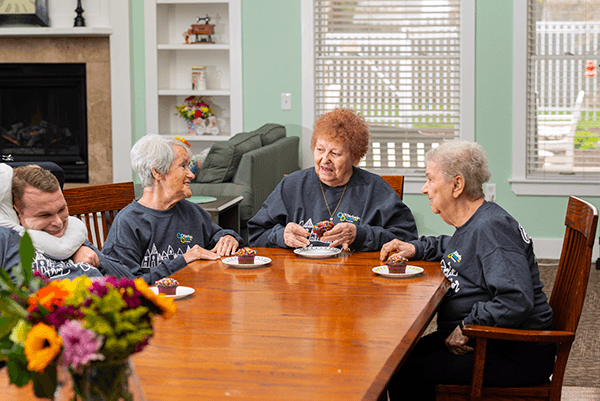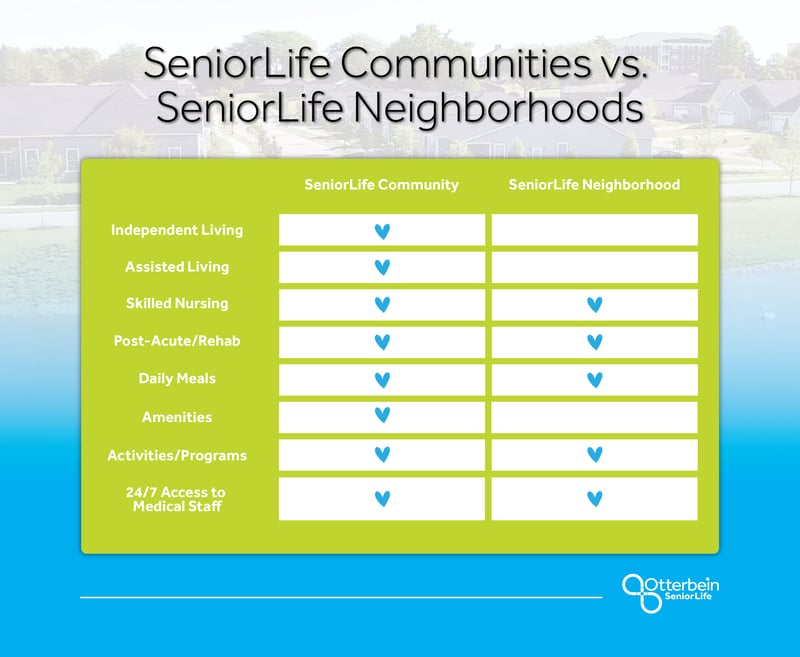If you’re considering senior living options for yourself or a loved one, you’ve likely noticed that there are many different options to choose from. It can be difficult to pinpoint the similarities and differences between locations and levels of service.
That’s why we want to make things easier for you as you search!
At Otterbein SeniorLife, our two most popular senior living options are called SeniorLife Communities and SeniorLife Neighborhoods. While the two names sound similar, each has its own distinct characteristics. This blog will explain what each model is and simplify the similarities and differences between them, in addition to offering tips on which may be a better fit for you or your loved one.
What is a SeniorLife Community?
At Otterbein, a SeniorLife Community is what’s known as a continuing care retirement community. In the senior living industry, this kind of community offers a wide range of service levels and living options. All Otterbein SeniorLife Communities offer the following:
- Independent Living
- Assisted Living
- Post-Acute Care/Rehabilitation
- Skilled Nursing/Long-Term Care

In simpler terms, a SeniorLife Community is what you might typically think of when you picture a “retirement community.” Virtually everything residents need is located on a single campus, from apartments, homes, or suites, to dining venues and wellness services, to amenities like a fitness center and pool. The lifestyles of residents at a SeniorLife Community vary based on what level of service they are receiving, and residents can move from one level to another as their needs change.
What is Life Like at a Continuing Care Retirement Community? Find Out >>>
Otterbein has a total of nine SeniorLife Communities, which are located throughout northwest, southwest, and central Ohio, and in central Indiana.
What is a SeniorLife Neighborhood?
An Otterbein SeniorLife Neighborhood is what’s known as a small house neighborhood, a care model that embraces highly individualized care in a small, home-like environment. Otterbein is a member of the Green House Project, a nationwide initiative aimed at revolutionizing eldercare by establishing small house neighborhoods ― or “Green House” homes ― across the country.
SeniorLife Neighborhoods offer skilled nursing and post-acute care/rehabilitation and consist of multiple small houses, each of which houses 10-12 elders. Unlike traditional nursing homes, SeniorLife Neighborhoods provide:
- Private rooms with private bathrooms
- Central hearth/living room area
- Open kitchen and dining area
- Home-cooked meals served family-style
- Freedom to choose your own daily schedule
Compare SeniorLife Neighborhoods to Traditional Nursing Home With This Free Guide >>>
Otterbein has a total of nine SeniorLife Neighborhoods, which are located in northwest, southwest, and central Ohio ― near the major cities of Toledo, Cincinnati, and Columbus.
What are the Main Differences?
The most obvious difference between SeniorLife Communities and SeniorLife Neighborhoods is the physical size and space in which residents/elders live and interact. SeniorLife Communities are much larger and embrace a community atmosphere, whereas SeniorLife Neighborhoods provide a smaller, more intimate setting focused on relationships between a small group of elders and staff.
Another main difference is the levels of service that are offered. SeniorLife Communities offer all levels of service, from independent and assisted living to skilled nursing, while SeniorLife Neighborhoods only offer skilled nursing care (including post-acute care/rehab).
What Do SeniorLife Communities and SeniorLife Neighborhoods Have in Common?
As both SeniorLife Communities and SeniorLife Neighborhoods are both part of Otterbein SeniorLife, you can expect the same high-quality service and general philosophy from both.
No matter what level of service they are receiving, every resident, guest, and elder is treated with respect and is valued. Otterbein staff partners (employees) are skilled, compassionate, and focused on enriching the lives of the seniors they serve.
In addition, both SeniorLife Communities and SeniorLife Neighborhoods place high importance on relationship-building between both residents/elders and staff partners. Communities do this on a larger scale by hosting community-wide events and activities, daily interactions between residents and partners, and more, whereas neighborhoods help elders connect with each other as a family-like unit and bond with consistent staff partners one-on-one each day.
Which is Right for Me (or My Loved One)?
Of course, you are the only one who can answer this question, but there are some general factors that could make one more preferable for your situation.
SeniorLife Communities are a great choice for those looking for any level of service, whether it’s independent living, assisted living, skilled nursing, or post-acute care/rehabilitation. For those looking to be part of a close-knit community, the vibrant community atmosphere at SeniorLife Communities can be extremely fulfilling, and there is always some kind of activity or event to participate in.
SeniorLife Communities are also ideal for those who want peace of mind about their future care needs. Residents can move into independent living earlier in life and know that if they ever need assisted living, skilled nursing, or rehab, it’s available right on campus.
SeniorLife Neighborhoods, on the other hand, are an appropriate option for those who need more extensive, around-the-clock care, whether it’s long-term skilled nursing or short-term post-acute care/rehabilitation. For those who would like lots of one-on-one interaction with staff partners and fellow elders, neighborhoods provide an intimate setting that is the next best thing to home.
Is a Small House Neighborhood Right for Your Loved One? Take This Quiz to Find Out >>
More Helpful Resources to Guide Your Search
If you’re looking into long-term care for a loved one but aren’t sure what to do next, this free resource ― Your Guide to Finding and Choosing Long-Term Care ― can help you get started. With tips for assessing your loved one’s needs, talking to family members and loved ones, researching options, and more, this guide can help you get on the right track.


